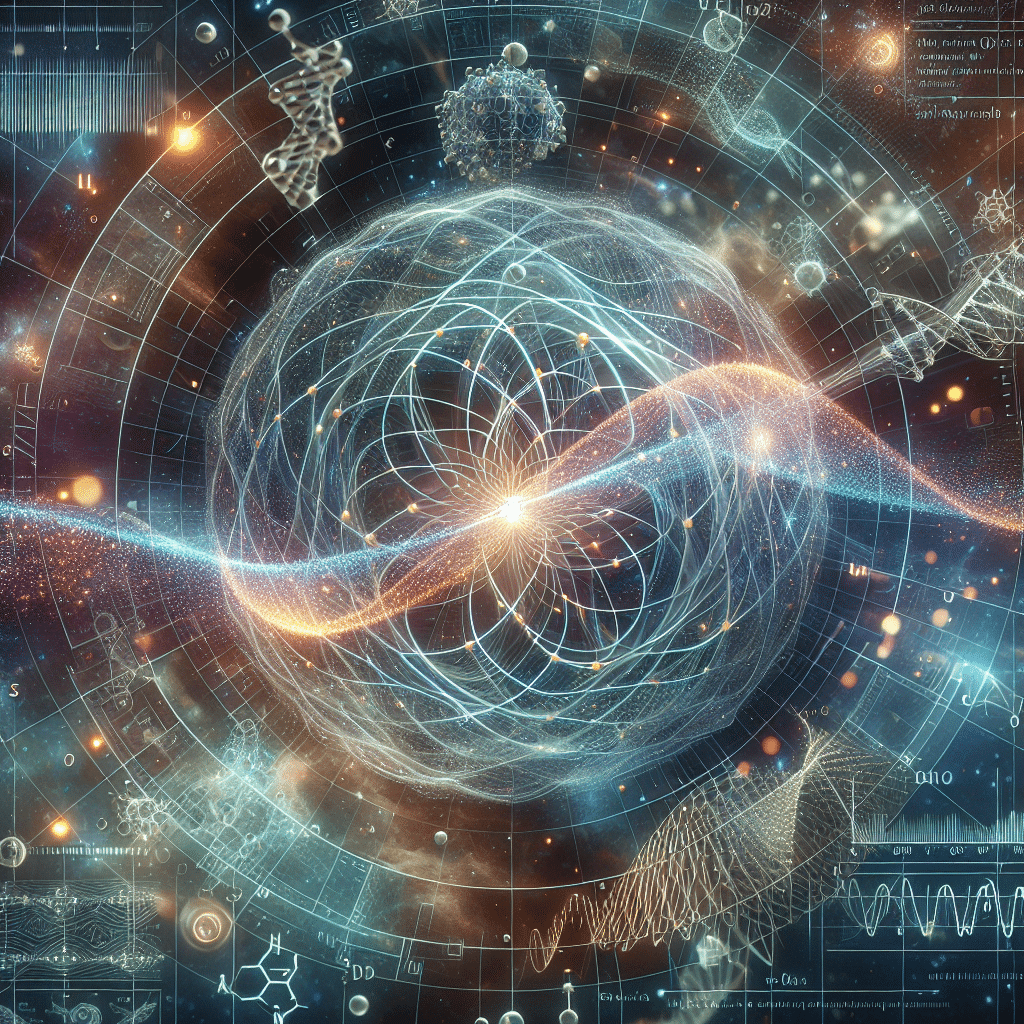Mathematical Summary (sum of e−αr waves)
1) Ansatz (two particles A and B)
Model each particle as a monochromatic, localized, isotropic source of a complex scalar field (the “matter wave”):
\[ \psi_A(\mathbf r,t)=A\,e^{-\alpha|\mathbf r-\mathbf r_A|}\,e^{-i\omega_1 t}, \qquad \psi_B(\mathbf r,t)=B\,e^{-\beta|\mathbf r-\mathbf r_B|}\,e^{-i\omega_2 t} \]
and superpose:
\[ \Psi(\mathbf r,t)=\psi_A(\mathbf r,t)+\psi_B(\mathbf r,t) \]
Switch to spherical coordinates around B: write \(\mathbf r=\mathbf r_B+\mathbf s\) with \(r=|\mathbf s|\ll R\), and define:
\[ R=|\mathbf r_B-\mathbf r_A|,\quad |\mathbf r-\mathbf r_B|=r,\quad |\mathbf r-\mathbf r_A|=|\mathbf R-\mathbf s| \]
For \(r\ll R\):
\[ |\mathbf R-\mathbf s|\approx R- r\cos\theta + O(r^2/R) \]
so near B:
\[ \psi_A(\mathbf r,t)\approx A\,e^{-\alpha R}\,e^{+\alpha r\cos\theta}\,e^{-i\omega_1 t}, \qquad \psi_B(\mathbf r,t)=B\,e^{-\beta r}\,e^{-i\omega_2 t} \]
At the point \(B_0\) (i.e. \(r=0\)), the contribution from A is:
\[ \psi_A(B_0,t)=A\,e^{-\alpha R}\,e^{-i\omega_1 t} \]
2) Which wave equation to use?
The correct free Schrödinger equation is:
\[ i\hbar\,\partial_t\Psi = -\frac{\hbar^2}{2m}\,\nabla^2\Psi \]
Its stationary states are oscillatory plane/spherical waves; an envelope \(e^{-\alpha r}\) alone is not an exact free-Schrödinger solution.
To obtain exponential profiles, use the Helmholtz or Poisson equation:
\[ (\nabla^2-\mu^2)\,\phi(\mathbf r,t)= -4\pi\,S(\mathbf r)\,e^{-i\omega t} \;\;\Rightarrow\;\; G_\mu(r)=\frac{e^{-\mu r}}{4\pi r} \]
For a point source:
\[ \phi_A(\mathbf r,t)=\frac{S_A}{4\pi}\,\frac{e^{-\mu|\mathbf r-\mathbf r_A|}}{|\mathbf r-\mathbf r_A|}\,e^{-i\omega_1 t} \]
In the quasi-static limit \(\mu\to 0\):
\[ G_0(r)=\frac{1}{4\pi r} \]

3) Effective potential and the 1/R law
If B couples to A’s field with coupling \(g_B\), the interaction energy is:
\[ V_{AB}(R,t)= \frac{g_A g_B}{4\pi}\,\frac{e^{-\mu R}}{R}\cos(\omega_1 t+\varphi) \]
After time averaging (or if \(\omega_1\simeq\omega_2\)):
\[ V_{AB}(R)\propto \frac{e^{-\mu R}}{R} \]
The corresponding force is:
\[ \mathbf F(R)=-\frac{g_A g_B}{4\pi}\,e^{-\mu R}\left(\frac{1}{R^2}+\frac{\mu}{R}\right)\hat{\mathbf R} \]
In the long-range limit \(\mu R\ll 1\), this reproduces a 1/R² gravity-like law.
4) Useful identities (quick validation)
Laplacian of radial exponentials:
\[ \nabla^2(e^{-\alpha r})= e^{-\alpha r}\left(\alpha^2-\frac{2\alpha}{r}\right) \]
Green’s function identity:
\[ \nabla^2\!\left(\frac{e^{-\mu r}}{r}\right)=\mu^2\frac{e^{-\mu r}}{r}-4\pi\delta(\mathbf r) \]
The 1/r singularity (and the far-field 1/R law) comes from the structure of the Green’s function \(G(r)\sim 1/r\), not from a bare \(e^{-\alpha r}\) without the \(1/r\) factor.
In two lines
- Superpose localized waves: \(\Psi=\psi_A+\psi_B\) with envelopes \(e^{-\alpha r}\).
- To obtain a potential \(\sim 1/R\) (and force \(\sim 1/R^2\)), the mediator must obey Poisson/Helmholtz: \(G(r)\sim e^{-\mu r}/r\). Then \(V_{AB}(R)\propto e^{-\mu R}/R\), and for \(\mu\to 0\): \(V\propto 1/R\).



